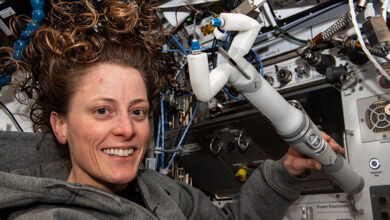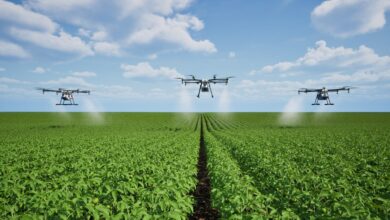Automate 2024: Robotics’ Shrinking Footprint Fits into Any Facility

Logistics and warehousing are in the middle of a robotic revolution, where automated machines are handling a growing number of tasks. This not only eases workloads for human workers, but it also frees them up to focus on more strategic, value-added tasks in the fulfillment environment.
Collaborative robots or “co-bots” are having an especially big impact in warehouses and distribution centers (DCs) thanks to their ability to work side-by-side with human labor forces to get goods received, stored, picked, packed and shipped faster and more accurately.
The robotics themselves are also getting smaller and able to fit and operate in smaller spaces. In this Insider Q&A, Nicole Clement, Comau’s advanced automation solutions business unit chief, discusses the current trends in robotics, the challenges manufacturers are facing, how automation helps them solve those challenges and emerging innovation in robotics.
Q: What did you see at Automate this year?
A: I saw a lot of applications of automated intelligent bin picking, for starters. I also saw conveyor tracking in terms of picking an object from a conveyor that is allowing to pick complex objects at high speed, and the picking of different objects of different geometries and complexities. Across the board I saw vision being used for picking and sensing, plus intelligent robotics that use artificial intelligence (AI) to learn what to do, what to pick, what not to pick, what to sort, and what not to sort.
At the Automate show, there were also a lot of examples of very compact controllers that effectively help to reduce the robot’s footprint in the fulfillment center and much focus on sustainability and energy savings. Finally, we’ve reached a point where robotics can be applied in “unstructured environments” that feature less repeatable situations (versus the automotive sector, where the processes are all pretty repeatable).
For example, companies in the logistics sector deal with a lot of different SKUs, packaging changes and boxes. Their automation has to flexible, and we’re seeing more examples of companies stepping up to the plate to fill these needs.
Q: What top challenges are users struggling with right now?
A: Sustainability and energy efficiency are both top concerns right now, but companies are also worried about the footprints of their warehouses, manufacturing floors and other unstructured environments. Many facilities just don’t have a perfect floor to run a mobile robot on. They have a different surface where you have to think about, how can I automate in that unstructured environment?
At Comau, we offer one mobile robot solution for fulfilment, and we’re currently sourcing another second one to add to our portfolio. We’re also integrating third-party mobile robots in automotive for different sizes of mobile robots, outside of just warehouse automation applications.
Another concern is the lack of skills to program, run and maintain the automation that’s being installed in the warehousing and logistics environment.
Automation engineering is a rare skill that’s hard to find. People who can program and deploy robots aren’t easy to find and that’s driving a bigger need for more “low-code, no-code” software that effectively democratizes software development and makes it accessible to people with a wider range of technical backgrounds.
Last but not least variability of process, batchsize one and at the same time a need for high speed to deliver require easier to re-program automation solutions and intuitive, easy to use software to adapt process and improve usability.
Q: How does Comau help companies address and overcome these challenges?
A: For footprint reduction, sustainabilty and energy efficiency, we developed a new concept of modularity, lightweight and easy to maintain architecture. The modularity concept allows for lower maintenance as wear and tear is easier to address, Lighter weight supports energy efficiency. We’re also offering smaller cabinets and controllers. In terms of software, we’re deploying Intrinsic low code software approach and we are also able to offer an integrated solution with Siemens or Rockwell to enable our customers to program the robot through the existing PLC software used in most integrated automation lines.
Of course, robots are really just a “tool in the box.” The real value of robotics lies in what the robot does, how fast it does it, how accurate it does it, and how reliable that piece of automated machinery is. It’s about the process and the application, and less about the tool itself. We have a long-standing partnership with Rockwell, Siemens and Intrinsic, and we’re using the latter’s software to program in a very intuitive, fast, simplified manner. This is making robotics easier to program, manage and apply in the warehousing environment.
Q: Which new business verticals present the most opportunities for more robotics and automation?
A: Right now, we’re seeing some of the biggest opportunities in logistics and end-of-line assembly across multiple industry sectors, with food and beverage and pharma being some of the verticals with the biggest automation needs. As an Italian company, we’re naturally drawn to food. We have a food-certified robot and a robot for pharma that is clean room certified.
These robots can be used for palletizing, depalletizing, partially packaging, labeling, dispensing and even welding. In fact, we see major interest from the shipbuilding industry, which is having difficulties finding shipbuilders who are experienced with arc welding (i.e., the joining of metals together using the intense heat generated by an electric arc).
Comau’s new S-Family of small, high-speed robots combines efficiency and technical excellence with the features and functionality required for effective deployment within new markets and dedicated application areas. The robots are saltwater- and dust-resistant and have the very small footprints that for example shipbuilders and other industries require.
Q: What’s coming next for robotics in the warehouse and logistics environments?
A: Robots will be used more and more to deal with tasks like palletizing, depalletizing, intelligent picking and sorting, mobile robots will replace space taking conveyers and software will need to become easier and easier to use to keep up with the need for faster and faster delivery. Automated truck unloading is a field that is challenged now by few players and soon to be solved by many. Cobots will be increasingly used for lighter weight tasks, replacing some industrial robots for certain applications. Comau has a perfect product to do both, industrial robotics and cobotics. The Cobot Racer5 shown at this show, able to work in industrial robot mode but also able to switch to Cobot mode, perfectly safe at any time through a sensor based solution, without the need to build fences around the robot, which saves space again.
This Robot/Cobot combines flexibility and collaborative safety features with high-performance repeatability and accuracy and allows reducing cycle times while ensuring better productive throughput. One area that’s still ripe for more innovation is gripper technology, which doesn’t necessarily work with cobots at this point. Cobots can manage anything up to 30 kilograms (66 pounds), but at some point they’re going to be limited in the way the axis works to lift heavier items. That said, I think we’re going to see more innovation in gripper technology going forward.



